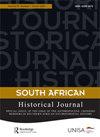Genetic Afterlives: Black Jewish Indigeneity in South Africa
IF 1
3区 历史学
Q1 HISTORY
引用次数: 2
Abstract
defected to the better resourced ANC, and the PAC’s woes were exacerbated it was expelled from various countries where it had bases. Even so, when Mothopeng was released from ‘Sun City’ (to which he had been transferred from the Island a few years earlier) on the grounds of ill-health in 1988, there were signs of the PAC’s resuscitation. Its president, however, was beyond help. Although he continued to make speeches at home and abroad and to mentor the youth, from whom he earned the title ‘Lion of Azania’, he was suffering from terminal cancer. He opposed negotiations with the apartheid government, calling instead for an intensification of the struggle. Hlongwane alludes to the conflict within the PAC about participation in the negotiations, suggesting that things might have turned out differently had Mothopeng not passed away, consumed by cancer, just as the now unbanned PAC was preparing for its first congress inside the country. The PAC’s successes should not be forgotten. It is important to recognise the forms in which the organisation endured into the 1980s through parts of the labour movement, the Azanian National Youth Unity, of which Hlongwane was a member, and the African Women’s Organisation under the leadership of Urbania Bebe Mothopeng. Her achievements deserve more exploration. Hlongwane has paid eloquent tribute to Mothopeng’s 50 years of service, suffering, sacrifice, and ‘consistent soldiering’ (200), while persuasively arguing for a better understanding of the ‘Lion of Azania’ and the PAC’s role ‘in the ideas of struggle and national liberation’ (206).遗传来生:南非黑人犹太人的土著
转而投奔了资源更充足的ANC, PAC的困境也随之加剧,它被驱逐出了多个拥有基地的国家。即便如此,当Mothopeng于1988年因健康状况不佳被从“太阳城”释放(几年前他被从岛上转移到那里)时,PAC有复苏的迹象。然而,它的总裁已无可救药。尽管他继续在国内外发表演讲,并指导青年,他因此赢得了“阿扎尼亚之狮”的称号,但他患有晚期癌症。他反对与种族隔离政府谈判,而是呼吁加强斗争。Hlongwane暗示了PAC内部关于参与谈判的冲突,暗示如果Mothopeng没有死于癌症,事情可能会有不同的结果,就在现在被禁止的PAC准备在国内举行第一次代表大会的时候。政治行动委员会的成功不应被遗忘。重要的是要认识到该组织在20世纪80年代通过工人运动的部分形式,阿扎尼亚民族青年联盟(Hlongwane是其成员)和Urbania Bebe Mothopeng领导下的非洲妇女组织(African Women’s organization)。她的成就值得进一步探索。洪瓦恩对莫索彭50年的服役、苦难、牺牲和“始终如一的战士”(200)表达了雄辩的敬意,同时有说服力地主张更好地理解“阿扎尼亚之狮”和PAC“在斗争和民族解放思想”中的作用(206)。
本文章由计算机程序翻译,如有差异,请以英文原文为准。
求助全文
约1分钟内获得全文
求助全文
来源期刊

South African Historical Journal
Multiple-
CiteScore
0.70
自引率
0.00%
发文量
37
期刊介绍:
Over the past 40 years, the South African Historical Journal has become renowned and internationally regarded as a premier history journal published in South Africa, promoting significant historical scholarship on the country as well as the southern African region. The journal, which is linked to the Southern African Historical Society, has provided a high-quality medium for original thinking about South African history and has thus shaped - and continues to contribute towards defining - the historiography of the region.
 求助内容:
求助内容: 应助结果提醒方式:
应助结果提醒方式:


